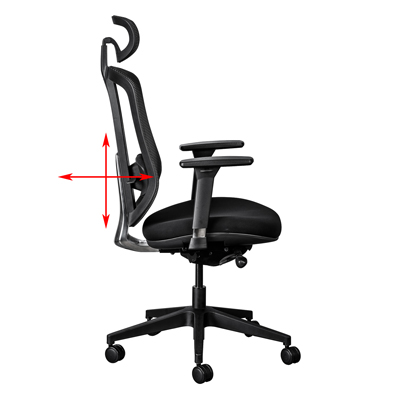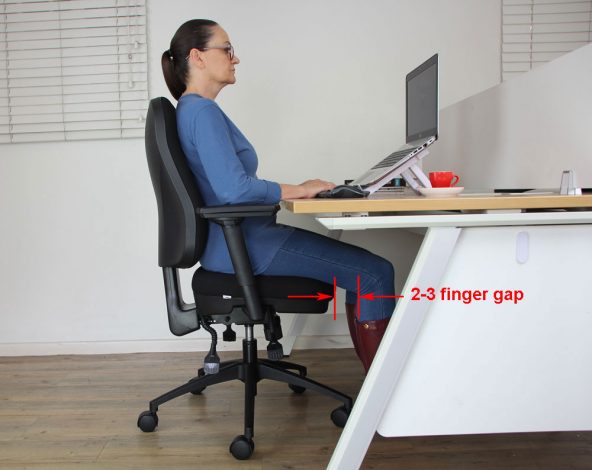- Your cart is empty
- Continue Shopping
What is an Ergonomic Chair?
According to Ergonomic Trends, “an Ergonomic Chair is one that not only follows best practices in terms of proven ergonomic
The world is changing…fast! The way we work and study at home in the twenty first century has changed, especially in light of the COVID pandemic. Using a dining room chair and table as a study desk, or even worse, your couch, can result in long-term health problems. Studies done on working professionals and university students have shown the adverse effects that incorrect sitting can have on your body.
The consequences of sitting on the wrong chair include, but are not limited to:
Poor blood circulation leading to poor concentration.
Poor posture causing musculoskeletal disorders such as neck, shoulder and back pain.
Fatigue, depression and anxiety.
Increased body fat and weight gain.
Decreased productivity.
Your health and wellbeing is important. Before you buy a study chair for your home office, what are the important features to look out for?
The Leila ergonomic chair is an extremely popular study chair, simply because it is an all-rounder that offers versatility and exceptional comfort, at an affordable price.
You should be able to adjust the height of your ergonomic chair to suit your own height and the desk you will be using it at. The correct way to adjust your chair height, is to do it away from the desk. Once your chair is at the right height, move it towards your desk and comfortably rest your forearms and wrists on the desk – your elbows should now be bent at about 900. If this is not the case, you may have to adjust the height of your desk. What is the correct ergonomic height for my desk, computer monitor and study chair?
Probably the most important feature of any chair is the level of back support. Everybody has a different shape back and each person will need support in different areas. You should be able to position the backrest of the chair in a way that suits your body shape and the way you prefer to sit while working. You must be able to change the angle between the backrest and the seat of the chair. What actually happens when you sit?
By altering this angle from an upright 90 degrees to a more reclined position of approximately 120 degrees (for e.g. when you are talking on the phone or gaming), you activate the muscles in the lumbar region of your back. This stimulates the flow of blood through the muscles and is known as dynamic sitting.
The activation of these muscles increases the blood flow which prevents lower back pain often caused by long periods of static sitting. The chair should have a locking mechanism that allows the backrest to be locked into numerous positions. When left unlocked (free-floating), the backrest should provide continuous support to your back by remaining in contact with your back and moving with you.
Ergonomic chairs and Orthopedic office chairs promote dynamic sitting. Ergonomic and Orthopedic chairs: Features & Differences
As discussed by Discovery Health, protecting your back is essential and your chair plays a CRITICAL role.
Both mesh and upholstered backrests are popular, and really it’s a matter of personal choice. Mesh chairs are more modern and are preferred by designers for their slim design and stylish looks.

A comfortable home office chair should include a lumbar support that can be adjusted vertically as well as horizontally (depth). The lumbar cushion should support your back in such a way that it is slightly arched and maintains it’s natural curvature.
Proper lumbar support is essential to minimise strain or compression of the lumbar discs in your spine.
The seat must include High-Density injection moulded foam because it provides additional support, is longer lasting, and will not collapse after a short period of use. Make sure that the moulded seat foam feels comfortable and fits the profile of your bottom. Don’t buy a chair with a soft foam seat as they quickly become uncomfortable.
Just like your car, a study chair with a firm seat will be more comfortable in the long run.
The chair seat should be wide and deep enough to let you sit comfortably between the armrests. If you are tall, look for a deeper seat, and a shorter one if you are not so tall.
When you sit properly in the chair, there should be a gap of 2-3 fingers between the front edge of the seat and the inside of your knees.
If a number of people of different heights are going to use your study chair, consider one that has seat depth adjustment. This feature allows you to make the seat shorter or longer depending upon the height of the user.

If you have limited space in your home office, armrests may restrict your movement. However, if you do have sufficient space, consider getting a chair with armrests for your study as they improve the overall ergonomics of your work space.
Armrests offer extra support as they take some of the strain off your neck and shoulders. Only consider armrests that are height adjustable. Modern armrests may also have an adjustable arm pad that can slide forward and back and will often allow for sideways or angled adjustment. What are the best armrests for my study chair?
Make sure all the important adjustment controls on your study chair can easily be reached from a seated position. This includes, seat height, armrest height, lumbar support, and backrest angle adjustment. It is always easier to get all the settings ‘exactly right’ if you are sitting on the chair.
Chair castors give you effortless mobility, but make sure to get the right ones for your floor. Nylon castors are suitable for carpet floors, while rubber or soft castors are suitable for hard surfaces like, tiles, wood and concrete. The castors should be at least 50mm in diameter. Larger castors improve manoeuvrability.
Many executive chairs have a headrest. This is a good option if you need additional neck and/or head support. . What is an executive office chair and when should you buy one?
Headrests are also popular for gaming or relaxing in the chair, especially when the backrest has been reclined.
Most of our ergonomic chairs are available with an optional headrest.
Buying a good study chair will have a positive impact on your health and wellbeing. In their article, this is what coronavirus will do to our offices and homes, the BBC shares their view of the future of working from home. In a nutshell, working from home is here to stay and we must prepare our home office accordingly.
According to Ergonomic Trends, “an Ergonomic Chair is one that not only follows best practices in terms of proven ergonomic
What is an orthopedic office chair and how does if differ from an ergonomic chair? Which is best for chronic lower back pain?
Office chairs have an array of levers and knobs to adjust the backrest, seat and armrests. How do you achieve a healthy sitting posture?